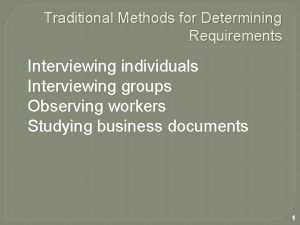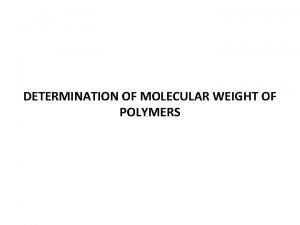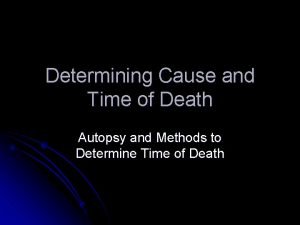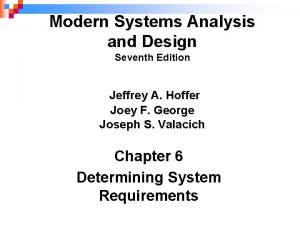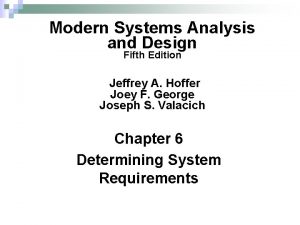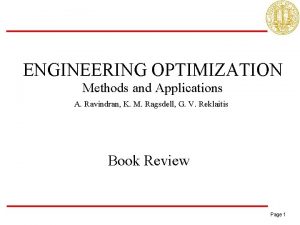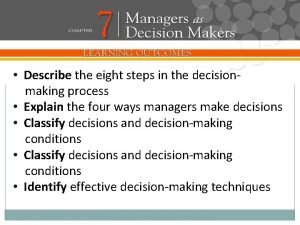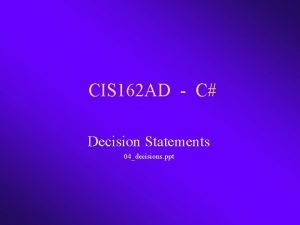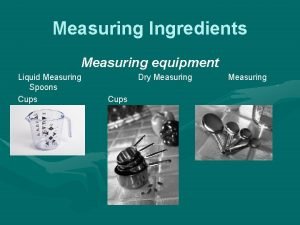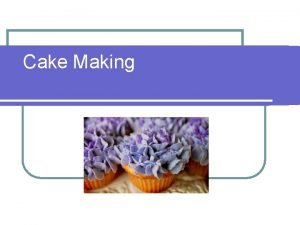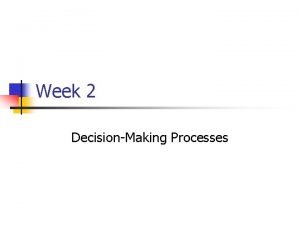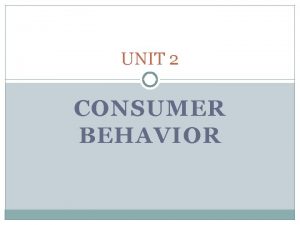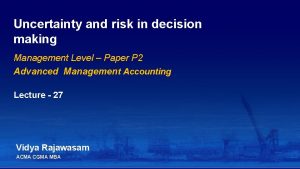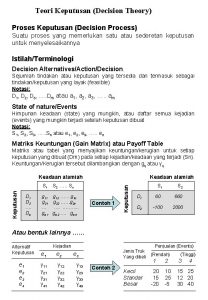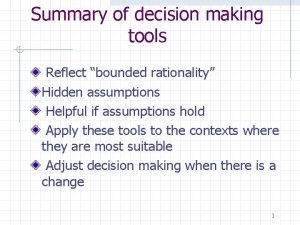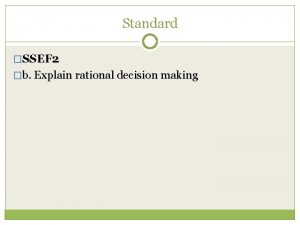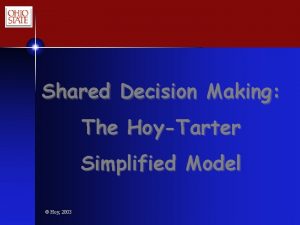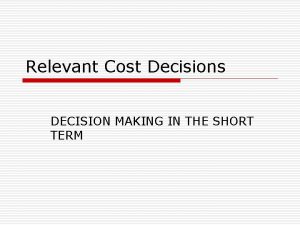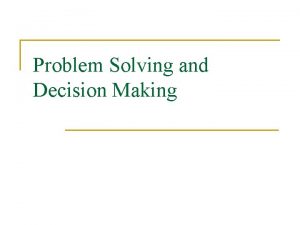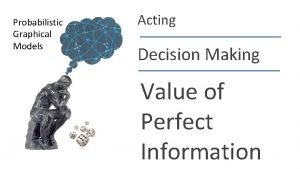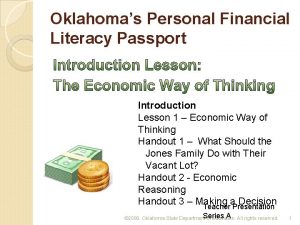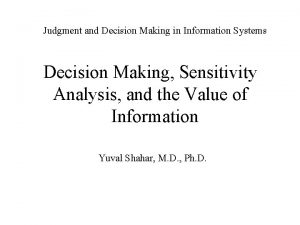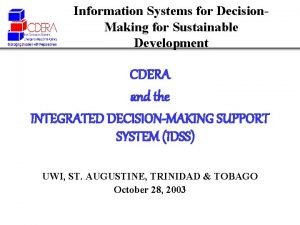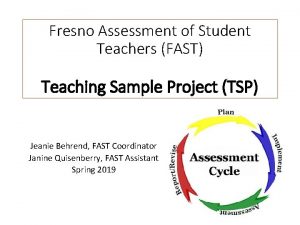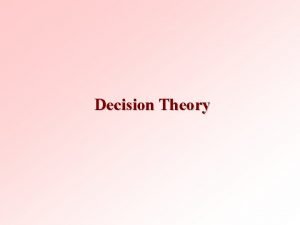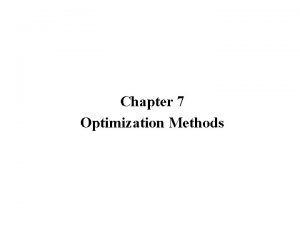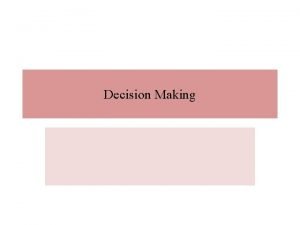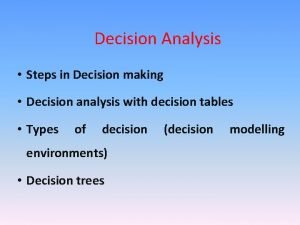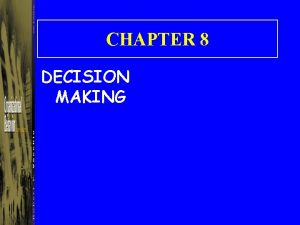Optimization Methods Decision making Examples determining which ingredients












![Search methods • Start with the interval (“bracket”) [x. L, x. U] such that Search methods • Start with the interval (“bracket”) [x. L, x. U] such that](https://slidetodoc.com/presentation_image_h/999ddab96671154a4c58346071d105c3/image-13.jpg)























![Rosenbrock’s function Minimum at [1, 1] Rosenbrock’s function Minimum at [1, 1]](https://slidetodoc.com/presentation_image_h/999ddab96671154a4c58346071d105c3/image-37.jpg)







































- Slides: 76

Optimization Methods

Decision making Examples: • determining which ingredients and in what quantities to add to a mixture being made so that it will meet specifications on its composition • allocating available funds among various competing agencies • deciding which route to take to go to a new location in the city • find the best clustering • Estimation of parameters of distributions • Learning classifiers • Decision making always involves making a choice between various possible alternatives

Categories of Decision making problems Category 1: • The set of possible alternatives for the decision is a finite discrete set typically consisting of a small number of elements. – Example: “A teenage girl knows four boys all of whom she likes, and has to decide who among them to go steady with. ” • Solution: scoring methods Category 2: • The number of possible alternatives is either infinite, or finite but very large, and the decision may be required to satisfy some restrictions and constraints • Solution: unconstrained and constrained optimization methods

The scoring method – an example Rita has been dating 4 boys off and on over the last 3 years, and has come to know each of them very well. Who among the four boys would be her best choice?

Category 2 Decision problems 1. Get a precise definition of the problem, all relevant data and information on it. • • Uncontrollable factors (random variables) Controllable inputs (decision variables) 2. Construct a mathematical (optimization) model of the problem. • Build objective functions and constraints 3. Solve the model • Apply the most appropriate algorithms for the given problem 4. Implement the solution

Optimization models • Single x Multiobjective models • Static x Dynamic models • Deterministic x Stochastic models

Problem specification Suppose we have a cost function (or objective function) Our aim is to find values of the parameters (decision variables) x that minimize this function Subject to the following constraints: • equality: • nonequality: If we seek a maximum of f(x) (profit function) it is equivalent to seeking a minimum of –f(x)

Books to read • Practical Optimization – Philip E. Gill, Walter Murray, and Margaret H. Wright, Academic Press, 1981 • Practical Optimization: Algorithms and Engineering Applications – Andreas Antoniou and Wu-Sheng Lu 2007 • Both cover unconstrained and constrained optimization. Very clear and comprehensive.

Further reading and web resources • Numerical Recipes in C (or C++) : The Art of Scientific Computing – William H. Press, Brian P. Flannery, Saul A. Teukolsky, William T. Vetterling – Good chapter on optimization – Available on line at (1992 ed. ) www. nrbook. com/a/bookcpdf. php (2007 ed. ) www. nrbook. com • NEOS Guide neos-guide. org • This powerpoint presentation www. utia. cas. cz

Types of minima f(x) strong local minimum weak local minimum strong global minimum feasible region strong local minimum x • which of the minima is found depends on the starting point • such minima often occur in real applications

Unconstrained univariate optimization Assume we can start close to the global minimum How to determine the minimum? • • Search methods (Dichotomous, Fibonacci, Golden-Section) Approximation methods 1. Polynomial interpolation 2. Newton method • • Combination of both (alg. of Davies, Swann, and Campey) Inexact Line Search (Fletcher)

1 D function As an example consider the function (assume we do not know the actual function expression from now on)
![Search methods Start with the interval bracket x L x U such that Search methods • Start with the interval (“bracket”) [x. L, x. U] such that](https://slidetodoc.com/presentation_image_h/999ddab96671154a4c58346071d105c3/image-13.jpg)
Search methods • Start with the interval (“bracket”) [x. L, x. U] such that the minimum x* lies inside. • Evaluate f(x) at two point inside the bracket. • Reduce the bracket. • Repeat the process. • Can be applied to any function and differentiability is not essential.

Search methods x. U x. L x. U Dichotomous Fibonacci: 1 1 2 3 5 8… Ik+5 Ik+4 Ik+3 Ik+2 Ik+1 Ik 1 2 3 x. L 5 8 x. U Golden-Section Search divides intervals by K = 1. 6180

Polynomial interpolation • Bracket the minimum. • Fit a quadratic or cubic polynomial which interpolates f(x) at some points in the interval. • Jump to the (easily obtained) minimum of the polynomial. • Throw away the worst point and repeat the process.

Polynomial interpolation • Quadratic interpolation using 3 points, 2 iterations • Other methods to interpolate? – 2 points and one gradient – Cubic interpolation

Newton method Fit a quadratic approximation to f(x) using both gradient and curvature information at x. • Expand f(x) locally using a Taylor series. • Find the δx which minimizes this local quadratic approximation. • Update x.

Newton method • avoids the need to bracket the root • quadratic convergence (decimal accuracy doubles at every iteration)

Newton method • Global convergence of Newton’s method is poor. • Often fails if the starting point is too far from the minimum. • in practice, must be used with a globalization strategy which reduces the step length until function decrease is assured

Extension to N (multivariate) dimensions • How big N can be? – problem sizes can vary from a handful of parameters to many thousands • We will consider examples for N=2, so that cost function surfaces can be visualized.

An Optimization Algorithm • Start at x 0, k = 0. 1. Compute a search direction pk 2. Compute a step length αk, such that f(xk + αk pk ) < f(xk) 3. Update xk+1 = xk + αk pk 4. Check for convergence (stopping criteria) e. g. df/dx = 0 or Reduces optimization in N dimensions to a series of (1 D) line minimizations k = k+1

Rates of Convergence x* … minimum p … order of convergence β … convergence ratio Linear conv. : Superlinear conv. : Quadratic conv. : p=1, β<1 p=1, β=0 or p>1 p=2

Taylor expansion A function may be approximated locally by its Taylor series expansion about a point x* where the gradient is the vector and the Hessian H(x*) is the symmetric matrix

Quadratic functions • • The vector g and the Hessian H are constant. Second order approximation of any function by the Taylor expansion is a quadratic function. We will assume only quadratic functions for a while.

Necessary conditions for a minimum Expand f(x) about a stationary point x* in direction p since at a stationary point At a stationary point the behavior is determined by H

• H is a symmetric matrix, and so has orthogonal eigenvectors • As |α| increases, f(x* + αui) increases, decreases or is unchanging according to whether λi is positive, negative or zero

Examples of quadratic functions Case 1: both eigenvalues positive with minimum positive definite

Examples of quadratic functions Case 2: eigenvalues have different sign with saddle point indefinite

Examples of quadratic functions Case 3: one eigenvalues is zero with parabolic cylinder positive semidefinite

Optimization for quadratic functions Assume that H is positive definite There is a unique minimum at If N is large, it is not feasible to perform this inversion directly.

Steepest descent • Basic principle is to minimize the N-dimensional function by a series of 1 D line-minimizations: • The steepest descent method chooses pk to be parallel to the gradient • Step-size αk is chosen to minimize f(xk + αkpk). For quadratic forms there is a closed form solution: Prove it!

Steepest descent • The gradient is everywhere perpendicular to the contour lines. • After each line minimization the new gradient is always orthogonal to the previous step direction (true of any line minimization). • Consequently, the iterates tend to zig-zag down the valley in a very inefficient manner

Conjugate gradient • Each pk is chosen to be conjugate to all previous search directions with respect to the Hessian H: • The resulting search directions are mutually linearly independent. Prove it! • Remarkably, pk can be chosen using only knowledge of pk , and -1,

Conjugate gradient • An N-dimensional quadratic form can be minimized in at most N conjugate descent steps. • • 3 different starting points. Minimum is reached in exactly 2 steps.

Powell’s Algorithm • • • Conjugate-gradient method that does not require derivatives Conjugate directions are generated through a series of line searches N-dim quadratic function is minimized with N(N+1) line searches

Optimization for General functions Apply methods developed using quadratic Taylor series expansion
![Rosenbrocks function Minimum at 1 1 Rosenbrock’s function Minimum at [1, 1]](https://slidetodoc.com/presentation_image_h/999ddab96671154a4c58346071d105c3/image-37.jpg)
Rosenbrock’s function Minimum at [1, 1]

Steepest descent • The 1 D line minimization must be performed using one of the earlier methods (usually cubic polynomial interpolation) • The zig-zag behaviour is clear in the zoomed view • The algorithm crawls down the valley

Conjugate gradient • Again, an explicit line minimization must be used at every step • The algorithm converges in 98 iterations • Far superior to steepest descent

Newton method Expand f(x) by its Taylor series about the point xk where the gradient is the vector and the Hessian is the symmetric matrix

Newton method For a minimum we require that with solution , and so . This gives the iterative update • • If f(x) is quadratic, then the solution is found in one step. The method has quadratic convergence (as in the 1 D case). The solution is guaranteed to be a downhill direction. Rather than jump straight to the minimum, it is better to perform a line minimization which ensures global convergence • If H=I then this reduces to steepest descent.

Newton method - example • The algorithm converges in only 18 iterations compared to the 98 for conjugate gradients. • However, the method requires computing the Hessian matrix at each iteration – this is not always feasible

Quasi-Newton methods • • If the problem size is large and the Hessian matrix is dense then it may be infeasible/inconvenient to compute it directly. Quasi-Newton methods avoid this problem by keeping a “rolling estimate” of H(x), updated at each iteration using new gradient information. Common schemes are due to Broyden, Goldfarb, Fletcher and Shanno (BFGS), and also Davidson, Fletcher and Powell (DFP). The idea is based on the fact that for quadratic functions holds and by accumulating gk’s and xk’s we can calculate H.

BFGS example • The method converges in 34 iterations, compared to 18 for the full-Newton method

Derivative-free optimization Downhill simplex method

Downhill Simplex

Comparison CG Quasi-Newton Downhill Simplex

Clustering example • Iterative minimization of • • • N … number of samples {x 1, …, x. N} K … number of clusters mean c(i) = {1, …, K} … membership function

Constrained Optimization Subject to: • Equality constraints: • Nonequality constraints: • Constraints define a feasible region, which is nonempty. • The idea is to convert it to an unconstrained optimization.

Equality constraints • Minimize f(x) subject to: for • The gradient of f(x) at a local minimizer is equal to the linear combination of the gradients of ai(x) with Lagrange multipliers as the coefficients.

f 3 > f 2 > f 1 x* is a minimizer, λ*<0 is not a minimizer x* is a minimizer, λ*>0 f 3 > f 2 > f 1 x* is not a minimizer

3 D Example

3 D Example f(x) = 3 Gradients of constraints and objective function are linearly independent.

3 D Example f(x) = 1 Gradients of constraints and objective function are linearly dependent.

Inequality constraints • Minimize f(x) subject to: for • The gradient of f(x) at a local minimizer is equal to the linear combination of the gradients of cj(x), which are active ( cj(x) = 0 ) • and Lagrange multipliers must be positive,

f 3 > f 2 > f 1 x* is not a minimizer, μ<0 No active constraints at x*, f 3 > f 2 > f 1 x* is a minimizer, μ>0

Lagrangien • We can introduce the function (Lagrangien) • The necessary condition for the local minimizer is and it must be a feasible point (i. e. constraints are satisfied). • These are Karush-Kuhn-Tucker conditions

Quadratic Programming (QP) • Like in the unconstrained case, it is important to study quadratic functions. Why? • Because general nonlinear problems are solved as a sequence of minimizations of their quadratic approximations. • QP with constraints Minimize subject to linear constraints. • H is symmetric and positive semidefinite.

QP with Equality Constraints • Minimize Subject to: • Ass. : A is p × N and has full row rank (p<N) • Convert to unconstrained problem by variable elimination: Z is the null space of A A+ is the pseudo-inverse. Minimize This quadratic unconstrained problem can be solved, e. g. , by Newton method.

QP with inequality constraints • Minimize Subject to: • First we check if the unconstrained minimizer is feasible. If yes we are done. If not we know that the minimizer must be on the boundary and we proceed with an active-set method. • xk is the current feasible point • is the index set of active constraints at xk • Next iterate is given by

Linear SVM • Binary classification: – Given training data (xi, yi) for i = 1. . . N, with xi ∈ Rd and yi ∈ {− 1, 1}, learn a classifier f(x) such that f(xi) ≥ 0 yi =+1 and f(xi)< 0 yi = − 1 i. e. yif(xi) > 0 for a correct classification. • Linear classifier: – where to put the hyperplane (w, b)?

Linear SVM maximizes the margin

Linear SVM • Learning the SVM can be formulated as an optimization: • or equivalently • This is a QP problem subject to inequality constraints

Active-set method • How to find dk? – To remain active thus – The objective function at xk+d becomes where • The major step is a QP sub-problem subject to: • Two situations may occur: or

Active-set method • We check if KKT conditions are satisfied and If YES we are done. If NO we remove the constraint from the active set with the most negative and solve the QP sub-problem again but this time with less active constraints. • We can move to but some inactive constraints may be violated on the way. In this case, we move by till the first inactive constraint becomes active, update , and solve the QP sub-problem again but this time with more active constraints.

General Nonlinear Optimization • Minimize subject to: f(x) where the objective function and constraints are nonlinear. 1. 2. 3. 4. 5. For a given approximate Lagrangien by Taylor series → QP problem Solve QP → descent direction Perform line search in the direction → Update Lagrange multipliers → Repeat from Step 1.

General Nonlinear Optimization Lagrangien At the kth iterate: and we want to compute a set of increments: First order approximation of and constraints: • • • These approximate KKT conditions corresponds to a QP program

SQP example Minimize subject to:

Linear Programming (LP) • • • LP is common in economy and is meaningful only if it is with constraints. Two forms: 1. Minimize subject to: 2. Minimize subject to: A is p × N and has full row rank (p<N) Prove it! QP can solve LP. If the LP minimizer exists it must be one of the vertices of the feasible region. A fast method that considers vertices is the Simplex method.

Non-linear least squares • It is very common in applications for a cost function f(x) to be the sum of a large number of squared residuals • If each residual depends non-linearly on the parameters x then the minimization of f(x) is a non-linear least squares problem.

Non-linear least squares • The M × N Jacobian of the vector of residuals r is defined as • Consider • Hence

Non-linear least squares • For the Hessian holds Gauss-Newton approximation • • • Note that the second-order term in the Hessian is multiplied by the residuals ri. In most problems, the residuals will typically be small. Also, at the minimum, the residuals will typically be distributed with mean = 0. • • For these reasons, the second-order term is often ignored. Hence, explicit computation of the full Hessian can again be avoided.

Gauss-Newton example • The minimization of the Rosenbrock function • can be written as a least-squares problem with residual vector

Gauss-Newton example • minimization with the Gauss-Newton approximation with line search takes only 11 iterations

Levenberg-Marquardt Algorithm • • For non-linear least square problems Combines Gauss-Newton with Steepest Descent Fast convergence even for very “flat” functions Descend direction : – Newton - Steepest Descent Gauss-Newton:

Comparison CG Quasi-Newton Gauss-Newton
 Objectives of decision making
Objectives of decision making Investment decision financing decision dividend decision
Investment decision financing decision dividend decision Traditional methods for determining requirements
Traditional methods for determining requirements End group analysis
End group analysis Which disease
Which disease Contemporary methods for determining system requirements
Contemporary methods for determining system requirements How can ngt be used for requirements determination
How can ngt be used for requirements determination Introduction of soap
Introduction of soap Engineering optimization methods and applications
Engineering optimization methods and applications Decision table and decision tree examples
Decision table and decision tree examples Describe the eight steps in the decision-making process
Describe the eight steps in the decision-making process Decision making statements in c with examples ppt
Decision making statements in c with examples ppt Defensible decision making social work
Defensible decision making social work Direct wax pattern technique
Direct wax pattern technique What are the four sizes of measuring spoons
What are the four sizes of measuring spoons Non essential ingredients examples
Non essential ingredients examples Cake making methods
Cake making methods Involvement decision making
Involvement decision making Social ethics
Social ethics Systematic decision making process
Systematic decision making process Paced decision making
Paced decision making Mamdm
Mamdm Using functions in models and decision making
Using functions in models and decision making What is this image
What is this image Unit 4 lesson 1 decision making
Unit 4 lesson 1 decision making Decision making unit example
Decision making unit example Types of decision making
Types of decision making Pestec higher business
Pestec higher business Contribution payoff table
Contribution payoff table Decision categories
Decision categories Marketing research definition
Marketing research definition Cdm decision making model
Cdm decision making model Contoh soal decision tree
Contoh soal decision tree Tactical decision making
Tactical decision making What is the dare decision making model
What is the dare decision making model Bounded rationality
Bounded rationality Mintzberg's modes of strategic decision making
Mintzberg's modes of strategic decision making Paced decision making
Paced decision making Chapter 6 prices and decision making assessment answers
Chapter 6 prices and decision making assessment answers Conditions of decision making
Conditions of decision making Site based decision making
Site based decision making Model hoy
Model hoy Decision making and relevant information
Decision making and relevant information Steps in decision making
Steps in decision making Decision making in healthcare
Decision making in healthcare Abcde decision making model
Abcde decision making model Problem space in psychology
Problem space in psychology Best books on problem solving and decision making
Best books on problem solving and decision making Individual and group decision making
Individual and group decision making What graphical model is appropriate for decision-making
What graphical model is appropriate for decision-making Individual and group decision making
Individual and group decision making Habitual decision making adalah
Habitual decision making adalah List the steps in the paced decision-making process.
List the steps in the paced decision-making process. Paced decision making
Paced decision making Stop method moral decision making
Stop method moral decision making Consumer decision making process
Consumer decision making process Executive support systems
Executive support systems Types of decision making in management
Types of decision making in management Contemporary theory of management
Contemporary theory of management Making decision is a fundamental life skill
Making decision is a fundamental life skill Perception and individual decision making
Perception and individual decision making Chapter 11 decision making and relevant information
Chapter 11 decision making and relevant information Knowledge based decision making
Knowledge based decision making Incremental decision making
Incremental decision making Judgment in managerial decision making 8th edition
Judgment in managerial decision making 8th edition Value of information in decision making
Value of information in decision making Integrated decision making
Integrated decision making Individual and group decision making
Individual and group decision making Clarityu
Clarityu Rubric for decision making
Rubric for decision making What are forms of government
What are forms of government Bok's model of ethical decision making
Bok's model of ethical decision making Routine decision making
Routine decision making 7 step ethical decision making model
7 step ethical decision making model Disposition model of decision-making
Disposition model of decision-making Chapter 2 economic systems and decision making
Chapter 2 economic systems and decision making Criterion of realism (hurwicz)
Criterion of realism (hurwicz)


